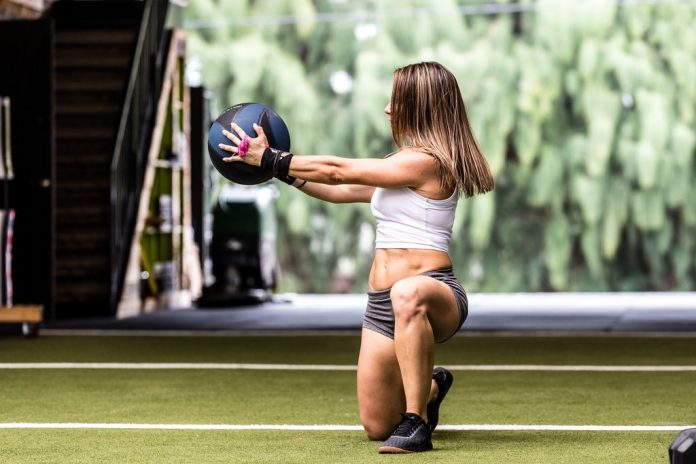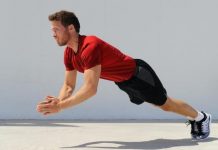The overhead lunge is one of the most functional, full-body strength-building movements you can do. With minimal equipment needed, you can gain strength, mobility, core strength, and stability. After you master the bodyweight lunge movement, progressing into the overhead lunge means bringing the weight away from your body, creating instability and unilateral, multi-joint movement, intensifying the exercise.
What Are The Benefits Of Doing Lunges
Lunges are a wonderful exercise that targets the quadriceps. However, they also work just about all of the other muscles of your lower body, including your glutes, hamstrings, and calves.
Begin With Basics: How To Do A Lunge
To perform a lunge, start by standing tall with your lower back naturally arched, a proud chest, shoulders back, and with feet hip-width apart.
Step forward with your left leg and slowly lower your body until your front knee is bent at least 90 degrees
When doing the lunge, visualize lowering your body straight down, not forward and down
Pause, then push through the front foot to the starting position as quickly as you can
Complete the prescribed number of repetitions by either alternating each leg or performing the full set with one leg before switching to the other
What Are The Benefits Of Doing Overhead Lunges
The overhead lunge has many variations and targets the core, quads, glutes, traps, hamstrings, and hip flexors. As an advanced plyometric movement, you can build both upper and lower body strength, increase peak power output, and propulsion from the legs, proprioception (special orientation), as well as improve core stability. When the weight is moved overhead, rather than on the shoulders or at the sides, the stabilizers in the shoulders (both upper and lower trap) are engaged, forcing your core muscles to fully lengthen and contract.
Before you get started with the overhead lunge, choose a weight such as a barbell, plate, dumbbell(s), or medicine ball. Whatever you select, make sure that the weight isn’t so heavy that it compromises your overhead lunge form. Remember, quality over quantity.
The 6 Best Overhead Lunge Variations For Full Body Sculpting And Strength – Swolverine
How To Do An Overhead Lunge
Whatever weight you decide to start with, the mechanic of the overhead lunge is the same whether you’re working with a dumbbell, medicine ball, barbell, broom, etc.
Start by standing tall, with your feet shoulder-width apart
Inhale and raise the weight overhead
Keeping the weight directly overhead with your biceps at the ears, center the shoulder joints and engage the muscles, bracing with the core
Exhale as you take a step forward with one leg, slowly lowering your body until your front knee is bent at least 90 degrees
Don’t allow the weight to carry you forward. Instead, think about dropping your hips straight down as you step forward. Keep your abs tight and chest up.
Inhale and pause, then push through the front foot backward starting position as quickly as you can
Complete the prescribed number of repetitions by either alternating each leg or performing the full set with one leg before switching to the other
The 6 Best Overhead Lunge Variations
The 6 Best Overhead Lunge Variations For Full Body Sculpting And Strength – Swolverine
1. Dumbbell Overhead Lunge
The dumbbell overhead lunge challenges the strength and coordination of the arms, shoulders, upper back, and the core. You can do this movement with 1 or 2 dumbbells, walking, or static. When the weights aren’t by your sides and are overhead, you turn the lunge into a full-body sculpting movement.
How Do You Do Dumbbell Overhead Lunges
Grab two dumbbells – stand tall with your feet shoulder-width apart
Inhale and raise the dumbbells overhead
Keeping the dumbbells directly overhead with your biceps at the ears, center the shoulder joints and engage the muscles, bracing with the core
Exhale as you take a step forward with one leg, slowly lowering your body until your front knee is bent at least 90 degrees
Don’t allow the weight to carry you forward. Instead, think about dropping your hips straight down as you step forward. Keep your abs tight and chest up.
Pause, then push through the front foot to the starting position as quickly as you can
Complete the prescribed number of repetitions by either alternating each leg or performing the full set with one leg before switching to the other
What is a Dumbbell Walking Lunge:
A dumbbell walking lunge takes the simple lunge movement and has you lunge with dumbbells in your hands down at your sides (or up overhead). This helps add weight to the movement, challenging the lower body, and promoting muscle growth. At the bottom of the lunge, instead of pushing your body backward do the starting position, raise up and bring your back foot forward so that you move forward (like you’re walking) a step forward with every rep.
2. Dumbbell Overhead Reverse Lunge
This movement is the same as the dumbbell overhead lunge and dumbbell overhead walking lunge, but you’re taking your movement and stepping backward, alternating legs.
Step backward with your left leg
Lower your body into a lunge (looks the same in a photo as a forward lunge)
Using the front foot and leg strength, push through the heel, stepping forward into your starting position
You can perform alternating dumbbell overhead reverse lunges or consecutive reps on the same leg before switching
The 6 Best Overhead Lunge Variations For Full Body Sculpting And Strength – Swolverine
3. Single-Arm Dumbbell Overhead Lunge
The single-arm dumbbell overhead lunge is the same as the dumbbell overhead lunge, but with only 1 weight in the hand that will be overhead. Holding a weight on just one side of the body increases the demand placed on your core to keep your body stable
Grab a dumbbell in your right hand
Inhale, bringing the weight up to your shoulder, pressing it into the overhead lockout position
Step forward into a lunge with your right foot, letting your left hand hang next to your side (if you need more stability, hold the left arm out)
Keeping your torso upright at all times, step back into the starting position
Complete the prescribed number of reps on that side, then switch arms and lunge with your left leg for the same number of reps (you can also alternate legs each time)
The 6 Best Overhead Lunge Variations For Full Body Sculpting And Strength – Swolverine
4. Barbell Overhead Lunge
As you progress in your ability with the lunge and overhead lunge, the barbell can prove to be a very effective tool for building strength, agility, and stability. That being said, since you can add so much weight to a barbell, it’s important to secure the proper overhead position with good form without compensating your cervical flexion or spinal extension, placing unnecessary stress on the spine during overhead holds and carries.
How To Do Barbell Overhead Walking Lunge
Keeping the weight in the heels, start by creating tension in the quads, glutes, and core
Maintaining a shoulder-width stance throughout the movement, power snatch the weight overhead with a snatch grip, or wider than shoulder-width grip
Press the bar overhead, locking in the shoulder joints, armpits facing forward
Maintaining an ‘active shoulder’ throughout the movement, step one foot forward until you reach at least 90 degrees, bending the back leg until your knee lightly taps/touches the ground
Press through both legs evenly to stand, bringing the back leg forward into your next step, ensuring that the torso remains over the hips throughout the entirety of the movement
The 6 Best Overhead Lunge Variations For Full Body Sculpting And Strength – Swolverine
5. Overhead Plate Lunge
The plate that you use for performing overhead plate lunges should be one that you can hold overhead for at least 30 seconds. A plate heavier than this can cause you to compromise your form and potentially cause injury.
Grab your plate with both hands at 3 and 9 (like on a clock) and raise it overhead until the arms are overhead and in a locked out position
Starting with the feet shoulder-width apart, step forward with one leg, bending the knees to lower the hips vertically, with the shoulders stacked over the hips reaching the 90-degree angle
Drive through the heel of the front foot, straightening the legs, and raising yourself back up.
To perform the walking lunge with weight overhead aka walking overhead plate lunges, simply drive up to the starting position, and take another step forward with the opposite foot instead of backward into the starting position
The 6 Best Overhead Lunge Variations For Full Body Sculpting And Strength – Swolverine
Overhead Lunge With Twist (Walking Lunge With Overhead Twist)
The overhead lunge with a twist targets the abdominals, glutes, quads, hip flexors, and hamstrings while improving balance and proprioception. You can do this movement with, or without weight, as a warmup or as a main movement.
In your starting position, lockout the arms with the weight overhead, bracing the core and holding it this way throughout the movement
Keeping the torso upright, step forward with your right leg and lower your body until your right knee is bent at least 90 degrees
For support, you can rest the back knee on the ground as you progress to the twisting motion, or for a more challenging movement, you can keep the back knee off the ground
As you lunge, rotate your upper body with the weight (remaining upright) to the right, squeezing the glutes
Bring the arms back to center and eventually up overhead, as you reverse the movement back to the starting position in a slow, controlled movement pattern
Complete the prescribed number of reps, then do the same number with your left leg, rotating the weight to the left side of the body as you lower
Common Mistakes When Performing The Overhead Lunge
If you’re having trouble performing the overhead lunge or any of the variations, slow it down and take a look at your movement.
The Weight Is Too Heavy (this will keep you from having a strong form)
The Weight Is ‘Sinking’ (another indication to bring the weight down)
Poor Shoulder Mobility
A Weak Core/Abdominal Section
Too Short of Steps/Knee Going Over The Toe
Too Narrow Of Stance (the feet & steps should be shoulder-width apart throughout to ensure stability and balance)
Forgetting About Posture (the shoulders should remain vertical over the hips with a braced core and proud chest)
Need a modification? No problem! Start with your lunge form, then bodyweight overhead lunges. From here, add in something lightweight, like a PVC pipe, broomstick, or stability ball until you feel more comfortable with higher weight/rep sets.
All in all, the overhead lunge and overhead lunge variations are a simple, yet highly effective plyometric movement that everyone (not just Crossfitters) should be doing. Build strength, stability, and motor control with the overhead lunge. Ready to up the ante? Increase the speed, repetitions, and/or weight, and watch the body fat shred off with every rep!


























